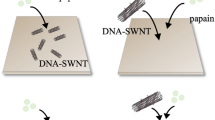Abstract
The authors have previously demonstrated the manipulation of bacteria and carbon nanotubes (CNTs) using dielectrophoresis (DEP) and its application for various types of biological and chemical sensors. This paper demonstrates simultaneous DEP handling of bacteria and CNTs, which are mixed and suspended in water. The CNTs were solubilized in water using microplasma-based treatment. When a microelectrode was energized with an ac voltage in the suspension of Escherichia coli (E. coli) cells and multi-walled CNTs (MWCNTs), both of them were simultaneously trapped in the microelectrode gap. Scanning electron microscopy (SEM) images revealed that E. coli cells were trapped on the surface or the tip of MWCNTs, where the electric field strength was intensified due to high aspect ratio of MWCNTs. As a result, bio/nano interfaces between bacteria and MWCNTs were automatically formed in a self-assembly manner. A potential application of the DEP-fabricated bio/nano interfaces is a drug delivery system (DDS), which is realized by transporting drug molecules from CNTs to cells across the cell membrane, which can be electroporated by the local high electric field formed on the CNT surface.







Similar content being viewed by others
References
Bianco A, Kostarelos K, Prato M (2005) Application of carbon nanotubes in drug delivery. Curr Opin Chem Biol 9:674–679
Bonard JM, Croci M, Klinke C, Kurt R, Noury O, Weiss N (2002) Carbon nanotube films as electron field emitters. Carbon 40:1715–1728
Chen J, Liu H, Weimer WA, Halls MD, Waldech DH, Walker GC (2002) Noncovalent engineering of carbon nanotube surfaces by rigid, functional conjugated polymers. J Am Chem Soc 124:9034–9035
Hennrich F, Krupke R, Kappes MM, Löhneysen HV (2005) Frequency dependence of the dielectrophoretic separation of single-walled carbon nanotubes. J Nanosci Nanotechnol 5:1166–1171
Hughes MP (2000) AC electrokinetics: applications for nanotechnology. Nanotechnology 11:124–132
Iijima S (1991) Helical microtubules of graphitic carbon. Nature 354:56–58
Imasaka K, Suehiro J, Kanatake Y, Kato Y, Hara M (2006) Preparation of water-soluble carbon nanotubes using a pulsed streamer discharge in water. Nanotechnology 17:3421–3427
Imasaka K, Suehiro J, Kato Y (2007) Enhancement of microplasma-based water-solubilization of single-walled carbon nanotubes using gas bubbling in water. Nanotechnology 18, Paper No.335602
Islam MF, Rojas E, Bergey DM, Johnson AT, Yodh AG (2003) High weight fraction surfactant solubilization of single-wall carbon nanotubes in water. Nano Lett 3:269–273
Kang S, Pinault M, Pfefferle LD, Elimelech M (2007) Single-walled carbon nanotubes exhibit strong antimicrobial activity. Langmuir 23:8670–8673
Luong JHT, Hrapovic S, Wang D, Bensebaa F, Simard B (2004) Solubilization of multiwall carbon nanotubes by 3-aminopropyltriethoxysilane towards the fabrication of electrochemical biosensors with promoted electron transfer. Electroanalysis 16:132–139
Nakajima T, Matsuo Y (1994) Formation process and structure of graphite oxide. Carbon 32:469–475
Pethig R (1996) Dielectrophoresis: using inhomogeneous AC electrical fields to separate and manipulate cells. Crit Rev Biotechnol 16:331–348
Pethig R (2007) BioMEMS and biomedical nanotechnology, vol II: micro/nano technologies for genomics and proteomics. Springer, US
Rojas-Chapana JA, Correa-Duarte MA, Ren Z, Kempa K, Giersig M (2004) Enhanced introduction of gold nanoparticles into vital Acidothiobacillus ferrooxidans by carbon nanotube-based microwave electroporation. Nano Lett 4:985–988
Suehiro J, Yatsunami R, Hamada R, Hara M (1999) Quantitative estimation of biological cell concentration suspended in aqueous medium by using dielectrophoretic impedance measurement method. J Phys D Appl Phys 32:2814–2820
Suehiro J, Shutou M, Hatano T, Hara M (2003a) High sensitive detection of biological cells using dielectrophoretic impedance measurement method combined with electropermeabilization. Sens Actuators B Chem 96:144–151
Suehiro J, Hamada R, Noutomi D, Shutou M, Hara M (2003b) Selective detection of viable bacteria using dielectrophoretic impedance measurement method. J Electrostat 57:157–168
Suehiro J, Zhou G, Hara M (2003c) Fabrication of a carbon nanotube-based gas sensor using dielectrophoresis and its application for ammonia detection by impedance spectroscopy. J Phys D Appl Phys 36:L109–L114
Suehiro J, Zhou G, Imakiire H, Ding W, Hara M (2005) Controlled fabrication of carbon nanotube NO2 gas sensor using dielectrophoretic impedance measurement. Sens Actuators B Chem 108:398–403
Suehiro J, Imakiire H, Hidaka S, Ding W, Zhou G, Imasaka K, Hara M (2006a) Schottky-type response of carbon nanotube NO2 gas sensor fabricated onto aluminum electrodes by dielectrophoresis. Sens Actuators B: Chem 114:943–949
Suehiro J, Sano N, Zhou G, Imakiire H, Imasaka K, Hara M (2006b) Application of dielectrophoresis to fabrication of carbon nanohorn gas sensor. J Electrostat 64:408–415
Suehiro J, Nakagawa N, Hidaka S, Ueda M, Imasaka K, Higashihata M, Okada T, Hara M (2006c) Dielectrophoretic fabrication and characterization of a ZnO nanowire-based UV photosensor. Nanotechnology 17:2567–2573
Suehiro J, Hidaka S, Yamane S, Imasaka K (2007) Fabrication of interfaces between carbon nanotubes and catalytic palladium using dielectrophoresis and its application to hydrogen gas sensor. Sens Actuators B: Chem 127:505–511
Tuukkanen S, Toppari JJ, Kuzyk A, Hirviniemi L, Hytönen VP, Ihalainen T, Törmä P (2006) Carbon nanotubes as electrodes for dielectrophoresis of DNA. Nano Lett 6:1339–1343
Washizu M, Kurosawa O (1990) Electrostatic manipulation of DNA in microfabricated structures. IEEE Trans Ind Appl 26:1165–1172
Zheng M, Jagota A, Semke ED, Diner BA, McLean RS, Lustig SR, Richardson RE, Tassi NG (2003) DNA-assisted dispersion and separation of carbon nanotubes. Nature Mater 2:338–342
Zhou R, Wang P, Chang HC (2006) Bacteria capture, concentration and detection by alternating current dielectrophoresis and self-assembly of dispersed single-wall carbon nanotubes. Electrophoresis 27:1376–1385
Author information
Authors and Affiliations
Corresponding author
Rights and permissions
About this article
Cite this article
Suehiro, J., Ikeda, N., Ohtsubo, A. et al. Fabrication of bio/nano interfaces between biological cells and carbon nanotubes using dielectrophoresis. Microfluid Nanofluid 5, 741–747 (2008). https://doi.org/10.1007/s10404-008-0276-6
Received:
Accepted:
Published:
Issue Date:
DOI: https://doi.org/10.1007/s10404-008-0276-6




